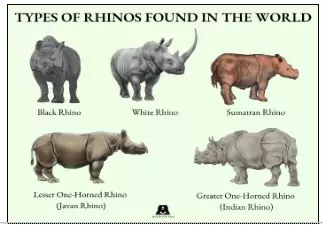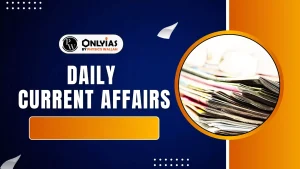The 2025 IUCN–TRAFFIC report commends India and Nepal for strengthening monitoring and surveillance, significantly reducing rhino poaching and supporting population growth.
Trade Records Analysis of Flora and Fauna in Commerce (TRAFFIC)
- TRAFFIC is an international non-governmental organisation that works to ensure trade in wild plants and animals does not threaten biodiversity conservation.
- Establishment: Established in 1976 as a joint programme of the World Wildlife Fund (WWF) and the International Union for Conservation of Nature (IUCN).
- Headquarters: Cambridge, United Kingdom
Role and Functions
- Monitors both legal and illegal wildlife trade to assess its impact on species and ecosystems.
- Provides data, analysis, and policy recommendations to governments, conservation agencies, and enforcement bodies.
- Works to strengthen law enforcement against illegal trade and promote sustainable use of wildlife resources.
Initiative In India
- In India, TRAFFIC, as a program division of WWF-India, has been actively working since 1991 to combat illegal wildlife trade, promote sustainable trade, and support policy development.
- For example “Don’t Buy Trouble” campaign
|
Key Findings on the State of Rhinos in 2024
- Global Rhino Population: The global wild rhino population is approximately 26,700, excluding those in zoos.
- African Rhino Status: In Africa, the black rhino population showed a positive trend, increasing from 6,195 to 6,788.
- Conversely, the white rhino population in South Africa declined to 15,752
- South Asian Conservation Success: India and Nepal have seen a significant increase in their greater one-horned rhino populations due to strong trans-boundary management and strict government protection.
- The total population in these countries rose to 4,075, with 3,323 in India and 752 in Nepal, marking an increase of 61 since 2022.
- Effective Anti-Poaching Measures: Reduced poaching incidents in India and Nepal are credited to enhanced law enforcement.
- From 2021 to 2024, only 9 rhinos were poached in India and 4 in Nepal, a testament to the success of these efforts.
- Concerning Trends in Asian Rhino Species: While some populations are growing, the status of several Asian rhino species remains critical.
- The Javan rhino population has dropped to around 50, while the Sumatran rhino population is considered “seriously imperiled,” with a stable but critically low count of 34–47 individuals.
About the IUCN–TRAFFIC Report

- Title: African and Asian Rhinoceroses – Status, Conservation and Trade.
- Commissioned by: Secretariat of the Convention on International Trade in Endangered Species of Wild Fauna and Flora (CITES).
- Prepared by: IUCN Species Survival Commission’s African Rhino Specialist Group, Asian Rhino Specialist Groups, and TRAFFIC.
- Publication Period Covered: Up to April 2025.
- Focus: Status, conservation efforts, and illegal trade in African and Asian rhino species.
About Rhinos
- Introduction: Rhinos are large herbivorous mammals, belonging to the family Rhinocerotidae, found in Africa and Asia.
Types of Rhinos
| Species |
Geographic Distribution / Habitat |
Conservation Status (IUCN) |
| Greater One-Horned Rhino (Rhinoceros unicornis) |
India, Nepal (grasslands, riverine forests) |
Vulnerable |
| Javan Rhino (R. sondaicus) |
Indonesia (Ujung Kulon National Park) |
Critically Endangered |
| Sumatran Rhino (Dicerorhinus sumatrensis) |
Indonesia (Sumatra, Borneo rainforests) |
Critically Endangered |
| White Rhino (Ceratotherium simum) |
Southern Africa (savannahs, grasslands) |
Near Threatened |
| Black Rhino (Diceros bicornis) |
Eastern and Southern Africa (savannahs, deserts) |
Critically Endangered |
Threats to Rhinos
- Poaching for Horns: Driven by illegal wildlife trade, especially in Asia.
- Use of Rhino horns in traditional Chinese medicines drives the illegal trade.
- Habitat Loss: Agricultural expansion, infrastructure, and human settlements.
- The habitat loss forces rhinos into smaller, fragmented areas, increasing competition for food and water, and making them more vulnerable to threats like poaching.
- Weak Enforcement: Some regions lack the capacity to deter poaching.
- Low Reproductive Rate: Rhinos have a long gestation period (15-18 months) with lower production rate making the population growth slow.
- Climate Change: Alters habitat quality due flooding or drought.
India’s Rhino Conservation Efforts
- Indian Rhino Vision-2020 (IRV-2020): It was aimed to increase the rhino population to 3,000 across different protected areas in Assam by 2020.
-
- It successfully increased the rhino population in Assam to nearly 3,000.
- Strict Protection in National Parks:
- Kaziranga, Pobitora, Orang, and Manas in Assam
- Dudhwa in Uttar Pradesh
- Jaldapara in West Bengal.
- Strengthened Monitoring: Increased patrolling, use of drones, and advanced surveillance.
- Legal Enforcement: Prosecution of offenders under the Wildlife Protection Act, 1972.
- Community Engagement: Awareness programs and eco-tourism initiatives to involve local populations.
- Translocation Projects: To expand rhino range and reduce poaching vulnerability.
![]() 8 Aug 2025
8 Aug 2025


